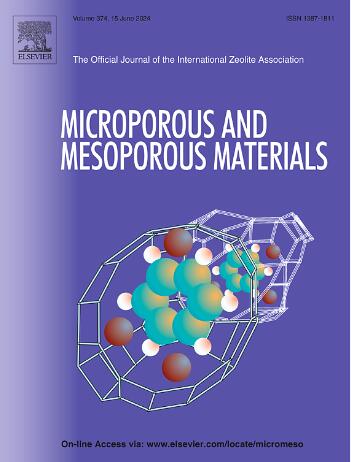Enhancement of the olefin selectivity over ZnSAPO-34 zeolite toward methanol-to-olefins conversion and its mechanistic interpretation
IF 4.8
3区 材料科学
Q1 CHEMISTRY, APPLIED
引用次数: 0
Abstract
The SAPO-34 zeolite serves as a crucial catalyst in the methanol-to-olefins (MTO) conversion to produce ethylene and propylene, yet suffering from the unsatisfied trade-off between long catalyst lifetime and high light olefins selectivity. Herein, we report a stable and efficient hierarchical ZnSAPO-34 zeolite prepared via hydrothermal method, which is featured with the successful introduction of Zn species into SAPO-34 framework. Impressively, the ZnSAPO-34 catalyst achieves a significantly enhanced ethylene selectivity of 60 % without obviously sacrificing catalyst lifetime. A combination study including online mass spectrometer (MS), 13C MAS NMR and in situ UV–visible (UV–vis) spectroscopy demonstrates that Zn species facilitate the initial generation of carbonyl species accompanied by the formation of hydrocarbon pool species, thus boosting the ethylene selectivity via the aromatic-based cycle. Meanwhile, the one-step introduction of Zn species leads to smaller crystal size and increases mesoporous in zeolite, enhancing the diffusion capacity of the ZnSAPO-34 sample, which accounts for the almost unchanged catalyst lifetime. The mechanistic interpretation provides a novel perspective to optimize zeolite catalysts by one-step introducing heteroatom, which shows potential applications in industrial MTO production.

ZnSAPO-34 沸石对甲醇-烯烃转化的烯烃选择性增强及其机理解释
SAPO-34分子筛作为甲醇制烯烃(MTO)转化生产乙烯和丙烯的关键催化剂,但在长催化剂寿命和高轻烯烃选择性之间存在不满意的权衡。本文采用水热法制备了一种稳定高效的ZnSAPO-34分子筛,其特点是成功地将Zn引入到SAPO-34骨架中。令人印象深刻的是,ZnSAPO-34催化剂在不明显牺牲催化剂寿命的情况下,乙烯选择性显著提高了60%。在线质谱(MS)、13C - MAS NMR和原位紫外可见光谱(UV-vis)联合研究表明,Zn物种促进羰基物种的初始生成,同时形成烃池物种,从而通过芳烃基循环提高乙烯选择性。同时,Zn的一步引入使得ZnSAPO-34的晶体尺寸变小,增加了分子筛的介孔,提高了ZnSAPO-34样品的扩散能力,这也是催化剂寿命几乎没有变化的原因。机理解释为一步引入杂原子优化沸石催化剂提供了新的视角,在MTO工业生产中具有潜在的应用前景。
本文章由计算机程序翻译,如有差异,请以英文原文为准。
求助全文
约1分钟内获得全文
求助全文
来源期刊

Microporous and Mesoporous Materials
化学-材料科学:综合
CiteScore
10.70
自引率
5.80%
发文量
649
审稿时长
26 days
期刊介绍:
Microporous and Mesoporous Materials covers novel and significant aspects of porous solids classified as either microporous (pore size up to 2 nm) or mesoporous (pore size 2 to 50 nm). The porosity should have a specific impact on the material properties or application. Typical examples are zeolites and zeolite-like materials, pillared materials, clathrasils and clathrates, carbon molecular sieves, ordered mesoporous materials, organic/inorganic porous hybrid materials, or porous metal oxides. Both natural and synthetic porous materials are within the scope of the journal.
Topics which are particularly of interest include:
All aspects of natural microporous and mesoporous solids
The synthesis of crystalline or amorphous porous materials
The physico-chemical characterization of microporous and mesoporous solids, especially spectroscopic and microscopic
The modification of microporous and mesoporous solids, for example by ion exchange or solid-state reactions
All topics related to diffusion of mobile species in the pores of microporous and mesoporous materials
Adsorption (and other separation techniques) using microporous or mesoporous adsorbents
Catalysis by microporous and mesoporous materials
Host/guest interactions
Theoretical chemistry and modelling of host/guest interactions
All topics related to the application of microporous and mesoporous materials in industrial catalysis, separation technology, environmental protection, electrochemistry, membranes, sensors, optical devices, etc.
 求助内容:
求助内容: 应助结果提醒方式:
应助结果提醒方式:


